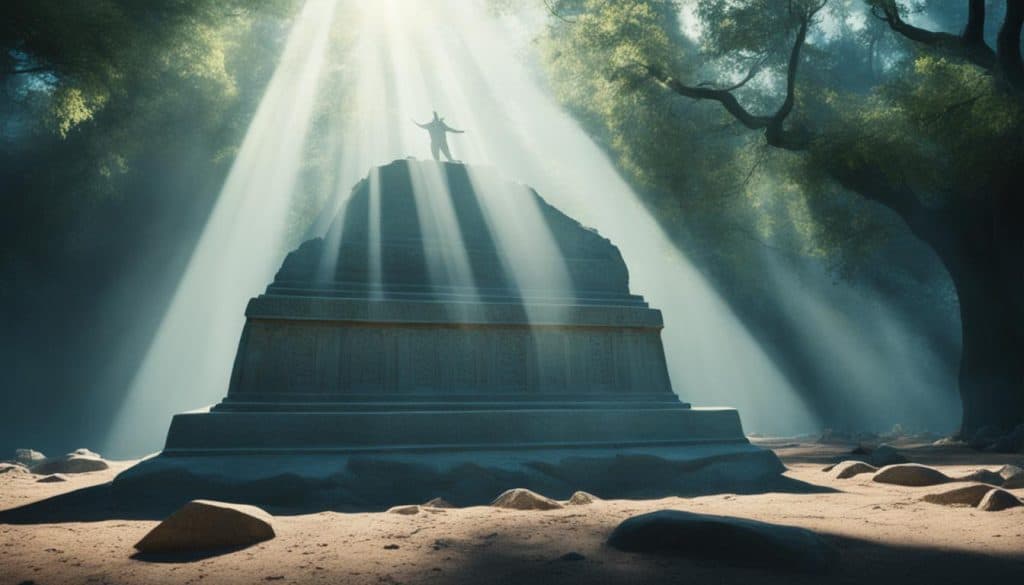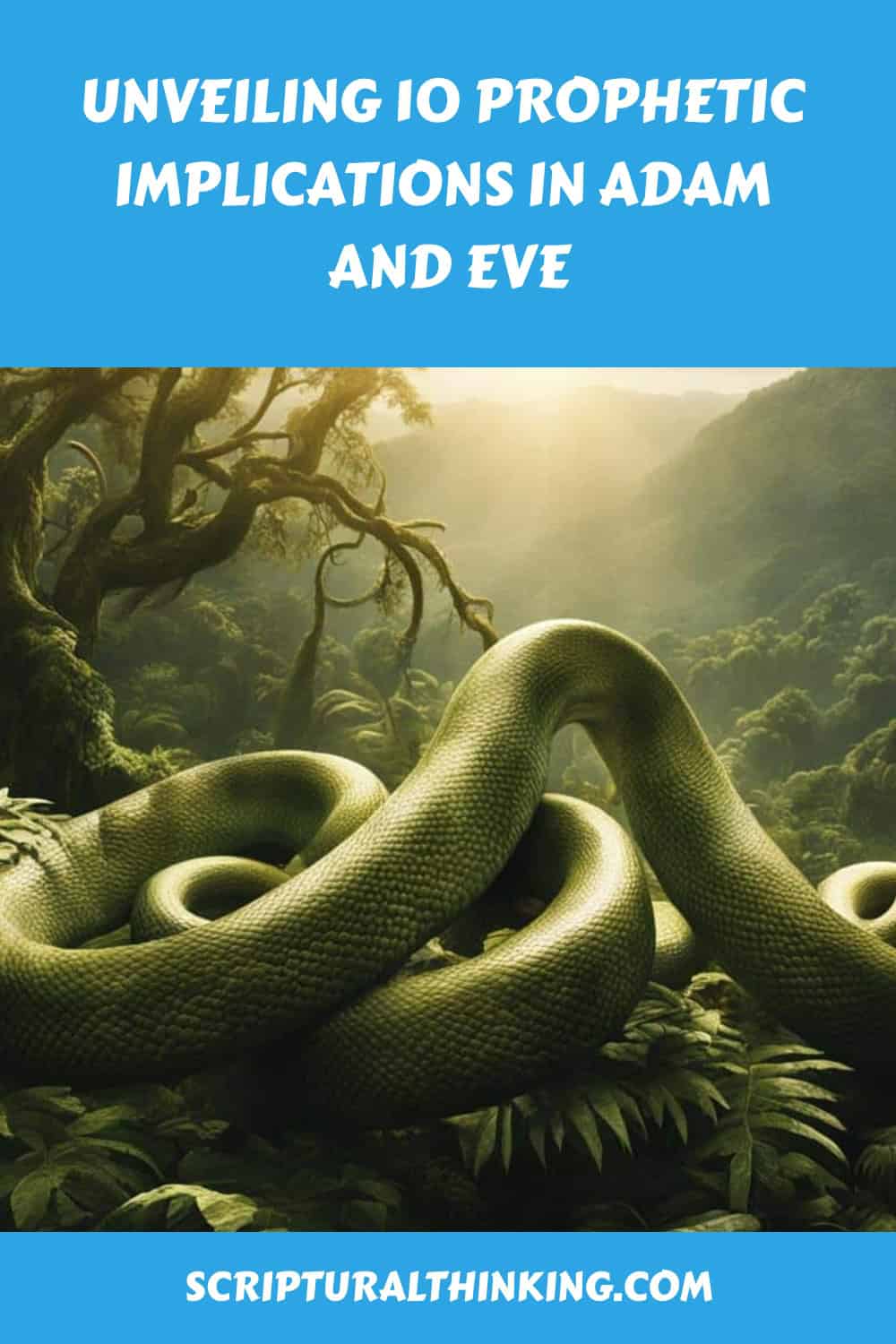Table of Contents
Journey back to the beginning of time and unlock the hidden mysteries within the story of Adam and Eve in Genesis.
Did you know that this ancient tale holds 10 prophetic implications that offer timeless truths for your spiritual journey?
Prepare to embark on a thought-provoking exploration that challenges common beliefs and sheds light on the deeper meaning behind humanity’s fall and ultimate redemption.
Are you ready to discover the profound insights that lie within the pages of Genesis?
Let’s delve into the secrets of Adam and Eve and uncover the profound revelations they hold for our spiritual lives.
Make Sure You Watch The Video: I would love for you to subscribe to my YouTube channel as well… Thanks in advance!!
The Proto-Evangelium and Christ’s Victory over Satan
The verse known as the proto-evangelium in Genesis 3:15 is considered the first gospel. It prophesies the enmity between the serpent (representing Satan) and the woman (Eve) and between their offspring.
This verse hints at Christ’s ultimate victory over Satan, foreshadowing his crucifixion (the serpent bruising his heel) and resurrection (he will crush the serpent’s head).
Throughout Scripture, the proto-evangelium in Genesis 3:15 is seen as a promise of Christ’s triumph over Satan. It sets the stage for the central theme of redemption and highlights the pivotal role of Jesus in overcoming the powers of darkness.
“And I will put enmity
between you and the woman,
and between your offspring and hers;
he will crush your head,
and you will strike his heel.”
This verse speaks of the ongoing battle between good and evil, with the serpent representing Satan and the woman’s offspring referring to Jesus Christ. It foreshadows Christ’s victory through his crucifixion and resurrection, where he ultimately defeats Satan and secures salvation for humanity.
By understanding the significance of the proto-evangelium in Genesis 3:15, we gain insight into the profound implications of Christ’s victory over Satan. It points to the crucial role of the crucifixion and resurrection in overcoming the power of sin and restoring humanity’s relationship with God.
The Fall and Redemption of Humanity
The fall of Adam and Eve in the Garden of Eden marked a pivotal moment in human history. Their disobedience to God led to a broken relationship between humanity and our creator.
However, amidst the consequences of their actions, a ray of hope emerged. This story prophesied the coming of a savior who would restore this broken relationship and offer redemption to all of humanity.
The narrative of Adam and Eve serves as a powerful reminder of our inherent need for salvation. By succumbing to temptation, Adam and Eve introduced sin into the world, causing a separation between God and humanity. We were left in a desperate state, longing for restoration.
But the story does not end there. The fall of Adam and Eve foreshadowed the arrival of a savior who would bring about redemption. This savior is none other than Jesus Christ, the Son of God.
Through his sacrificial death and resurrection, Jesus bridged the gap between God and humanity, offering us the opportunity to be reconciled with our Heavenly Father.
Jesus’ redemptive work on the cross restored what was broken in the Garden of Eden. Through him, we find forgiveness for our sins, healing for our brokenness, and a pathway to eternal life.
The theme of redemption can be traced throughout the Bible, showing that God’s plan for restoration was in motion from the beginning.
Through the story of Adam and Eve, we are reminded of the depth of God’s love and his desire to restore what was lost. It is a tale of brokenness and redemption, of a savior who came to rescue us from the consequences of our actions.
“For God so loved the world, that he gave his only Son, that whoever believes in him should not perish but have eternal life.” – John 3:16
In the next section, we will explore the initiation of the sacrificial system and its connection to the story of Adam and Eve, further unraveling the deep symbolism and prophetic implications of this timeless narrative.
The Initiation of the Sacrificial System
In the aftermath of Adam and Eve’s disobedience, God took a significant step that would foreshadow the ultimate sacrifice for humanity’s redemption. He clothed them in animal skins, symbolizing the beginning of the sacrificial system (Genesis 3:21).
This act initiated a sacrificial practice where animals would be offered as atonement for sins. It pointed towards the necessity of a perfect sacrifice to reconcile humanity with God.
“And the Lord God made for Adam and for his wife garments of skins and clothed them.”
This clothing of Adam and Eve with animal skins represented the covering of their shame and testified to the need for an innocent life to bear the consequences of sin. It foreshadowed the ultimate sacrifice of Jesus Christ on the cross for the atonement of humanity’s sins.
Just as the animal skins provided temporary forgiveness, Jesus Christ’s sacrifice on the cross brings eternal forgiveness and restoration to all who believe in Him.

The Symbolism of Animal Skins
By clothing Adam and Eve in animal skins, God introduced a powerful symbol with profound spiritual implications. The use of animal skins represented the cost of sin and pointed towards the ultimate sacrifice required to reconcile humanity with God.
“For the life of the flesh is in the blood, and I have given it for you on the altar to make atonement for your souls, for it is the blood that makes atonement by the life.” (Leviticus 17:11)
The sacrificial system established through the clothing of Adam and Eve anticipated the shedding of blood as an essential component for atonement. This symbolism continues throughout the Old Testament, culminating in the sacrifice of Jesus Christ, the perfect Lamb of God who takes away the sins of the world (John 1:29).
| Sacrificial System | Initiation | Symbolism |
|---|---|---|
| Animal Sacrifices | Clothing Adam and Eve in animal skins | Anticipation of Jesus Christ’s sacrifice |
| Blood Atonement | Essential component for forgiveness | Culminating in the sacrifice of Jesus Christ |
Banishment and Restoration
The expulsion of Adam and Eve from Eden symbolizes a significant turning point in their relationship with God. As a consequence of their disobedience, they were banished from the garden, experiencing a separation from the perfect communion they once enjoyed.
This exile from Eden reflects a broader theme of exile in the biblical narrative, pointing towards Israel’s own periods of exile and the eventual promise of restoration.
Just as Adam and Eve were exiled from the garden, the Israelites also faced exile due to their disobedience. However, throughout the Old Testament, prophets offered words of hope and restoration, promising that God would bring His people back to their land and restore their relationship with Him.
“Thus says the Lord God: ‘Behold, I will take the children of Israel from among the nations, wherever they have gone, and will gather them from every side and bring them into their own land.'” – Ezekiel 37:21
This prophetic promise of restoration extends beyond the Israelites and encompasses all of humanity. Through the banishment and eventual return of Adam and Eve, we see the universal journey of humanity from separation from God to restoration with Him.
The ultimate fulfillment of this prophetic promise is found in the New Jerusalem. In the book of Revelation, we catch a glimpse of this future city, where God dwells with His people in perfect harmony and restoration.
“And I saw the holy city, New Jerusalem, coming down out of heaven from God, prepared as a bride adorned for her husband.” – Revelation 21:2
This New Jerusalem represents the culmination of God’s redemptive plan, where the effects of the banishment from Eden are completely reversed. It is a place of perfect fellowship, harmony, and eternal restoration.
Key Takeaways
- The banishment of Adam and Eve foreshadowed the experiences of exile faced by the Israelites and symbolized humanity’s separation from God.
- Prophecies of restoration throughout the Old Testament offered hope that God would gather His people and restore their relationship with Him.
- The banishment and return of Adam and Eve reflect the universal journey of humanity from separation to restoration with God.
- The New Jerusalem represents the ultimate fulfillment of God’s prophetic promise of restoration, where perfect fellowship and harmony are restored for eternity.
Mortality, Resurrection, and Eternal Life
The introduction of physical death to Adam and Eve as a consequence of sin (Genesis 3:19) sets the stage for the prophetic promise of resurrection and eternal life. This theme is further developed throughout Scripture and finds fulfillment in the resurrection of Jesus Christ, offering hope for the redemption of humanity.
“For since death came through a man, the resurrection of the dead comes also through a man. For as in Adam all die, so in Christ all will be made alive.” 1 Corinthians 15:21-22 NIV
The consequence of sin not only brought mortality and physical death into the world but also opened the door to the prophetic promise of resurrection and eternal life. In the Old Testament, the hope of resurrection is hinted at in Job’s declaration:
“I know that my Redeemer lives, and that in the end, he will stand on the earth. And after my skin has been destroyed, yet in my flesh, I will see God.” Job 19:25-26 NIV
This prophetic promise finds its fulfillment in the resurrection of Jesus Christ, who conquered death and offers eternal life to all who believe in Him. Through His death and resurrection, Jesus defeated sin and provided the way for humanity to be reconciled with God and have the hope of eternal life.

| Key Points | Scripture References |
|---|---|
| Mortality and physical death entered the world as a consequence of sin. | Genesis 3:19; Romans 6:23 |
| The introduction of death served as a prophetic promise of resurrection and eternal life. | 1 Corinthians 15:21-22; Job 19:25-26 |
| The resurrection of Jesus Christ fulfilled the promise and offers hope for redemption and eternal life. | 1 Corinthians 15:20-23; John 11:25-26 |
Pain in Childbearing and the Birth of the Church
The increased pain in childbirth promised to Eve (Genesis 3:16) can be seen as a prophecy of the sorrow and joy involved in bringing forth new life. This parallels the pain and joy in the birth of the Church through Christ’s sacrifice. It reflects the ongoing process of spiritual growth and the sufferings that accompany it.
| Symbol | Description |
|---|---|
| Sorrow | The pain and anguish experienced during childbirth representing the consequences of sin. |
| Joy | The elation and fulfillment felt upon the birth of new life, mirroring the joy of the Church’s establishment through Christ’s sacrifice. |
| Childbirth | The physical process of delivering a baby into the world, symbolizing the spiritual growth and transformation of individuals within the Church. |
| Birth of the Church | The establishment and growth of the Church through the sacrifice of Jesus Christ, offering salvation and redemption to believers. |
| Christ’s Sacrifice | The ultimate act of love and redemption where Jesus willingly offered himself on the cross for the salvation of humanity. |
“Just as the pain of childbirth brings forth new life, so do the sufferings and sacrifices within the Church lead to spiritual growth and the birth of a vibrant and faithful community.”
The Curse on the Serpent and the Victory of Good over Evil
The curse on the serpent in Genesis 3:14 is a significant biblical prophecy that foreshadows the defeat of Satan and the ultimate victory of good over evil. This theme of triumphing over the forces of darkness is a recurring motif throughout the scriptures and holds great significance in understanding God’s plan for redemption.
In the story of Adam and Eve, after their disobedience and fall, God pronounces a curse upon the serpent:
So the Lord God said to the serpent:
“Because you have done this,
You are cursed more than all cattle,
And more than every beast of the field;
On your belly you shall go,
And you shall eat dust
All the days of your life.”
(Genesis 3:14)
This divine curse symbolizes the defeat and perpetual degradation of Satan, represented by the serpent. It is a powerful prophetic declaration that speaks of his ultimate demise and the victory of good over evil.
Throughout the Bible, we see how this victory unfolds through the life, death, and resurrection of Jesus Christ. His sacrificial love and triumph over sin and death bring hope and redemption to all who believe in Him.
The curse on the serpent is a reminder that evil will not prevail in the end. It serves as a testament to God’s faithfulness to His people and underscores the fulfillment of biblical prophecy. The defeat of Satan and the victory of good over evil are assured, providing comfort, strength, and hope to believers throughout history.
Summary:
The curse on the serpent in Genesis 3:14 is a powerful biblical prophecy that foretells the defeat of Satan and the ultimate victory of good over evil.
This divine curse symbolizes the perpetual degradation and downfall of Satan, confirming God’s plan for redemption and His faithfulness to His people. The life, death, and resurrection of Jesus Christ ultimately fulfill this prophecy, bringing hope and salvation to all who believe.

| Key Points | Details |
|---|---|
| The Curse | – Pronounced upon the serpent in Genesis 3:14 – Expresses perpetual degradation and defeat |
| Victory of Good over Evil | – Foreshadows the defeat of Satan – Reflects the triumph of good over evil in biblical prophecy – Fulfilled through the life, death, and resurrection of Jesus Christ |
| Assurance and Hope | – Confirms God’s plan for redemption – Provides comfort, strength, and hope to believers |
What Are the Prophetic Implications of the Mysteries Surrounding Adam and Eve?
The mysteries about Adam and Eve have far-reaching prophetic implications in various religious and spiritual traditions. These stories are often interpreted as symbolic of the human condition, free will, and the consequences of disobedience. Many believers look to these stories for insight into the nature of sin and redemption.
Access to the Tree of Life and Full Restoration
Revelation 22:14 holds a paramount prophetic promise that harks back to the story of Adam and Eve. It speaks of the eventual re-granting of access to the tree of life, a powerful symbol of full restoration and eternal life with God.
This promise paints a breathtaking picture of the future kingdom of God, where all who hold fast to their faith and follow His commands will partake in the glorious gift of eternal life.
Just as Adam and Eve were denied access to the tree of life after their disobedience, humanity has been yearning for the restoration of that intimate communion with God. In the grand tapestry of biblical prophecy, Revelation 22:14 shines as a beacon of hope, assuring us that our longing will be fulfilled.
Through the sacrifice of Jesus Christ and our unwavering commitment to Him, we will experience the fullness of restoration and the joy of eternal life.
This prophetic promise in Revelation 22:14 illuminates the ultimate purpose of God’s redemptive plan. It reveals His desire to bring humanity back into perfect harmony with Him, where sin and suffering will be no more.
The tree of life, once inaccessible, will become a tangible reality, reminding us that our eternal destiny is to dwell in the presence of God, forever restored and filled with abundant life.
Achieving access to the tree of life and experiencing full restoration and eternal life is not a mere wishful thinking. It is a breathtaking reality that awaits those who hold firm to their faith, trusting in the promises of God.
Let this prophetic promise stir your heart and deepen your longing for the future kingdom of God, where the tree of life stands as a testament to His love, grace, and the fullness of His redemptive work.






